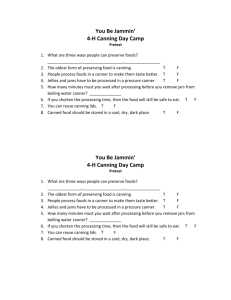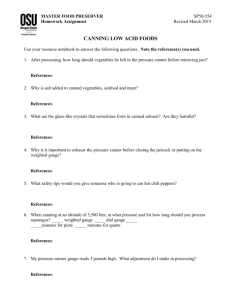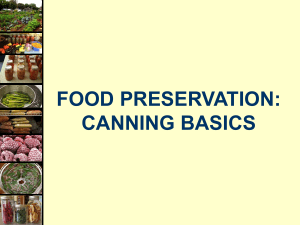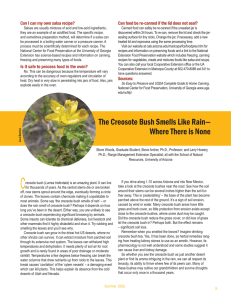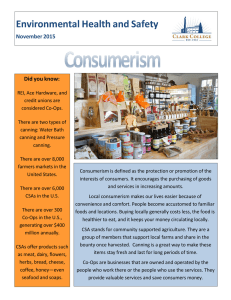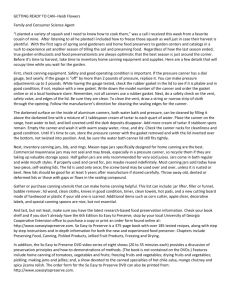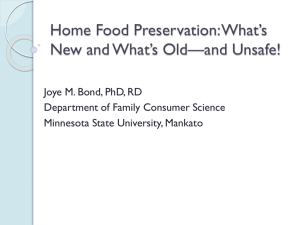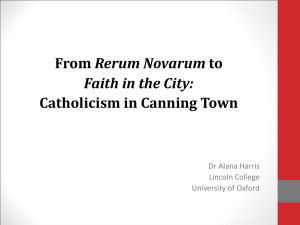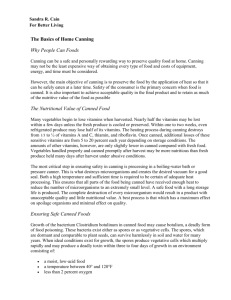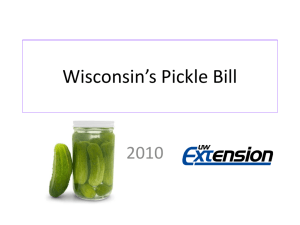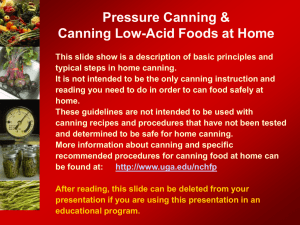Document 11277488
advertisement
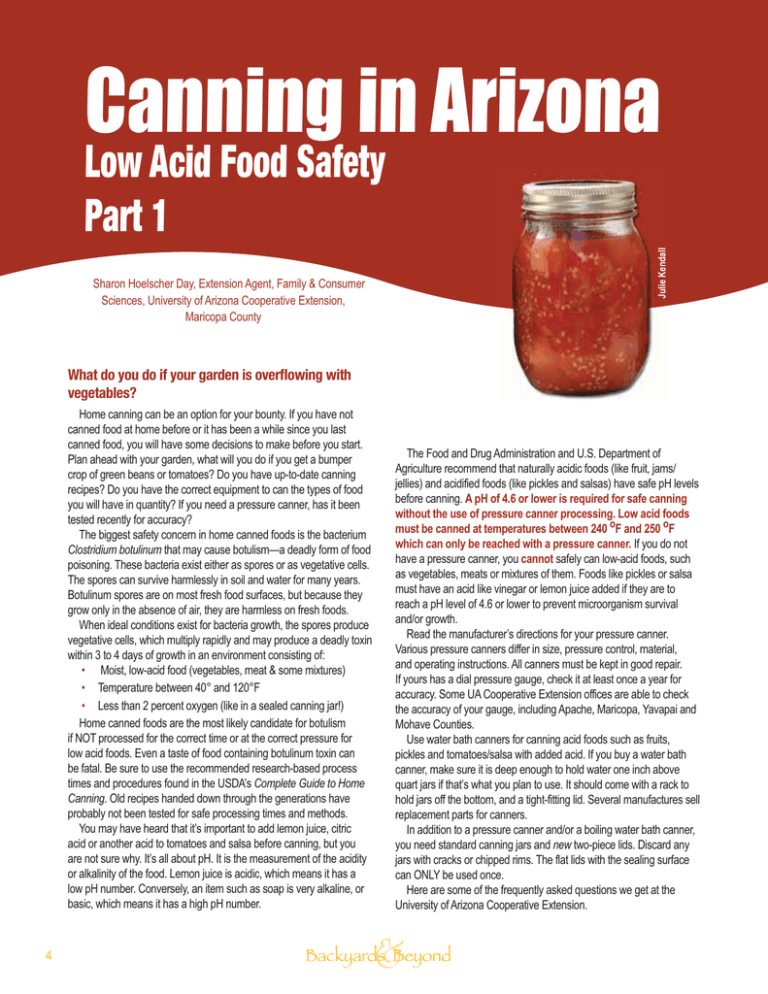
Canning in Arizona Julie Kendall Low Acid Food Safety Part 1 Sharon Hoelscher Day, Extension Agent, Family & Consumer Sciences, University of Arizona Cooperative Extension, Maricopa County What do you do if your garden is overflowing with vegetables? Home canning can be an option for your bounty. If you have not canned food at home before or it has been a while since you last canned food, you will have some decisions to make before you start. Plan ahead with your garden, what will you do if you get a bumper crop of green beans or tomatoes? Do you have up-to-date canning recipes? Do you have the correct equipment to can the types of food you will have in quantity? If you need a pressure canner, has it been tested recently for accuracy? The biggest safety concern in home canned foods is the bacterium Clostridium botulinum that may cause botulism—a deadly form of food poisoning. These bacteria exist either as spores or as vegetative cells. The spores can survive harmlessly in soil and water for many years. Botulinum spores are on most fresh food surfaces, but because they grow only in the absence of air, they are harmless on fresh foods. When ideal conditions exist for bacteria growth, the spores produce vegetative cells, which multiply rapidly and may produce a deadly toxin within 3 to 4 days of growth in an environment consisting of: • Moist, low-acid food (vegetables, meat & some mixtures) • Temperature between 40° and 120°F • Less than 2 percent oxygen (like in a sealed canning jar!) Home canned foods are the most likely candidate for botulism if NOT processed for the correct time or at the correct pressure for low acid foods. Even a taste of food containing botulinum toxin can be fatal. Be sure to use the recommended research-based process times and procedures found in the USDA’s Complete Guide to Home Canning. Old recipes handed down through the generations have probably not been tested for safe processing times and methods. You may have heard that it’s important to add lemon juice, citric acid or another acid to tomatoes and salsa before canning, but you are not sure why. It’s all about pH. It is the measurement of the acidity or alkalinity of the food. Lemon juice is acidic, which means it has a low pH number. Conversely, an item such as soap is very alkaline, or basic, which means it has a high pH number. 4 The Food and Drug Administration and U.S. Department of Agriculture recommend that naturally acidic foods (like fruit, jams/ jellies) and acidified foods (like pickles and salsas) have safe pH levels before canning. A pH of 4.6 or lower is required for safe canning without the use of pressure canner processing. Low acid foods must be canned at temperatures between 240 oF and 250 oF which can only be reached with a pressure canner. If you do not have a pressure canner, you cannot safely can low-acid foods, such as vegetables, meats or mixtures of them. Foods like pickles or salsa must have an acid like vinegar or lemon juice added if they are to reach a pH level of 4.6 or lower to prevent microorganism survival and/or growth. Read the manufacturer’s directions for your pressure canner. Various pressure canners differ in size, pressure control, material, and operating instructions. All canners must be kept in good repair. If yours has a dial pressure gauge, check it at least once a year for accuracy. Some UA Cooperative Extension offices are able to check the accuracy of your gauge, including Apache, Maricopa, Yavapai and Mohave Counties. Use water bath canners for canning acid foods such as fruits, pickles and tomatoes/salsa with added acid. If you buy a water bath canner, make sure it is deep enough to hold water one inch above quart jars if that’s what you plan to use. It should come with a rack to hold jars off the bottom, and a tight-fitting lid. Several manufactures sell replacement parts for canners. In addition to a pressure canner and/or a boiling water bath canner, you need standard canning jars and new two-piece lids. Discard any jars with cracks or chipped rims. The flat lids with the sealing surface can ONLY be used once. Here are some of the frequently asked questions we get at the University of Arizona Cooperative Extension. & Backyards Beyond Can I can my own salsa recipe? Can food be re-canned if the lid does not seal? Salsas are usually mixtures of acid and low-acid ingredients; they are an example of an acidified food. The specific recipe, and sometimes preparation method, will determine if a salsa can be processed in a boiling water canner or a pressure canner. A process must be scientifically determined for each recipe. The National Center for Food Preservation at the University of Georgia Extension has science-based recipes and information on canning, freezing and preserving many types of foods. Canned food can safely be re-canned if the unsealed jar is discovered within 24 hours. To re-can, remove the lid and check the jarsealing surface for tiny nicks. Change the jar; if necessary, add a new treated lid and reprocess using the same processing time. Visit our website at cals.arizona.edu/maricopa/fcs/foodpres.htm for recipes and information on preserving foods and a link to the National Extension Food Preservation website which includes freezing, canning recipes for vegetables, meats and mixtures foods like salsa and soups. You can also call your local Cooperative Extension office or the UA Cooperative Extension in Maricopa County at 602-470-8086 ext 341 to have questions answered. Is it safe to process food in the oven? Lisa Benton No. This can be dangerous because the temperature will vary according to the accuracy of oven regulators and circulation of heat. Dry heat is very slow in penetrating into jars of food. Also, jars explode easily in the oven. Sources: So Easy to Preserve and USDA Complete Guide to Home Canning, National Center for Food Preservation, University of Georgia www.uga. edu/nchfp/ The Creosote Bush Smells Like Rain— Where There is None Steve Woods, Graduate Student; Steve Archer, Ph.D., Professor; and Larry Howery, Ph.D., Range Management Extension Specialist; all with the School of Natural Resources, University of Arizona C reosote bush (Larrea tridentata) is an amazing plant. It can live for thousands of years. As the central stems die or are broken off, new stems sprout around the edge, eventually forming a circle of clones. The leaves contain chemicals making it unpalatable to most animals. Some say ‘the creosote bush smells of rain’ – or does the rain smell of creosote bush? Perhaps it depends on how long you’ve been in the desert. Either way, you are unlikely to see a creosote bush experiencing significant browsing by animals. Some insects can tolerate its chemical defenses, but livestock and other mammals find it highly distasteful and shun it. Try rubbing and smelling the leaves and you’ll see why. Creosote bush can grow in the driest hot US deserts, where no other shrubs can survive. It can extract moisture from parched soil through its extensive root system. The leaves can withstand high temperatures and dehydration. It needs plenty of soil air for root growth and is rarely found in areas of poor drainage or moderate rainfall. Temperatures a few degrees below freezing can break the water columns that draw nutrients up from roots to the leaves. This break causes ‘cavitation’ of the ‘xylem vessels’ – a damaging event which can kill plants. This helps explain its absence from the cold deserts of Utah and Nevada. If you drive along I -10 across Arizona and into New Mexico, take a look at the creosote bushes near the road. See how the soil around their stems can be several inches higher than the soil further away. This is ‘pedestalling’ – the base of the plant has become perched above the rest of the ground. It’s a sign of soil erosion, caused by wind or water. Many creosote bush areas have little grass and herb cover, so little protection from erosion exists except close to the creosote bushes, where some dust may be caught. Did the creosote bush reduce the grass cover, or did loss of grass let the creosote bush in? Perhaps both. But the effect remains – significant soil loss. Remember when you smelled the leaves? Imagine drinking creosote bush tea. Yes, it has been done, as herbal remedies ranging from treating kidney stones to use as an emetic. However, its pharmacology is not well understood and some studies suggest it can cause liver and kidney damage. So whether you see the creosote bush as just another desert plant or find its aroma intriguing in the rain, we can all respect its tenacity, its ability to thrive where few of its peers can. Many of these bushes may outlive our grandchildren and survive droughts that occur only once in a thousand years. Summer 2008 5
